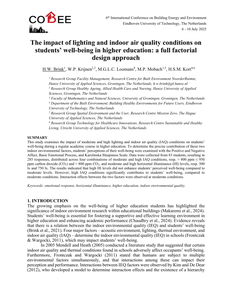This study examines the impact of moderate and high lighting and indoor air quality (IAQ) conditions on students’ well-being during a regular academic course in higher education. To determine the precise contribution of these two indoor environmental factors, students’ perceptions of their well-being were examined with the Positive and Negative Affect, Basic Emotional Process, and Karolinska Sleepiness Scale. Data were collected from 83 students, resulting in 285 responses, distributed across four combinations of moderate and high IAQ conditions, resp. > 800 ppm ≤ 950 ppm carbon dioxide (CO2) and < 800 ppm CO2, and moderate and high horizontal illuminance (HI) levels, resp. 500 lx and 750 lx. The results indicated that high HI levels did not enhance students’ perceived well-being compared to moderate levels. However, high IAQ conditions significantly contributes to students’ well-being, compared to moderate conditions. Interaction effects between the two factors were observed at moderate conditions.
DOCUMENT

The evolution of emerging technologies that use Radio Frequency Electromagnetic Field (RF-EMF) has increased the interest of the scientific community and society regarding the possible adverse effects on human health and the environment. This article provides NextGEM’s vision to assure safety for EU citizens when employing existing and future EMF-based telecommunication technologies. This is accomplished by generating relevant knowledge that ascertains appropriate prevention and control/actuation actions regarding RF-EMF exposure in residential, public, and occupational settings. Fulfilling this vision, NextGEM commits to the need for a healthy living and working environment under safe RF-EMF exposure conditions that can be trusted by people and be in line with the regulations and laws developed by public authorities. NextGEM provides a framework for generating health-relevant scientific knowledge and data on new scenarios of exposure to RF-EMF in multiple frequency bands and developing and validating tools for evidence-based risk assessment. Finally, NextGEM’s Innovation and Knowledge Hub (NIKH) will offer a standardized way for European regulatory authorities and the scientific community to store and assess project outcomes and provide access to findable, accessible, interoperable, and reusable (FAIR) data.
DOCUMENT
